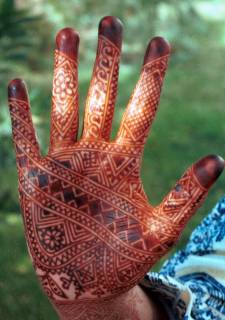My familiarity with the B'net Houariyat, acquired during my frequent journeys to Marrakech in the last few years, has enabled me to discover the existence of female musical practice, and the considerable extent to which it is spread in the popular urban context. The most recurrent family celebrations in the Islamic world provide the ordinary occasions on which exclusively female groups are commissioned. These occasions are births (mouloud), name-giving ceremonies for new-born children (sbo`a), boys' circumcisions (tohor), reunions of kin and loved ones in particular moments (such as the return of migrants during holidays or the return from the hajj, the pilgrimage to Mecca), engagement parties (khotbah), and weddings (`arsat).
The following piece, for instance, features the transformation of the desperate cry of a girl betrothed to an old man into a love song dedicated to her young lover. Aymma wa ya Lalla (Ah mother, ah lady)
Note: a indicates the first chorus (oughna); b indicates the second chorus (azima). For an explanation of the terms Hamada and Ferda cf. chapter 4. 1. The founder of the line of the Chorfa Rahaliyn (XVI century), whose sanctuary is in the village of the same name in the region of Marrakech (Naamouni 1994). Groups such as the B'net Houariyat, who animate henna parties and other events in domestic life, are generally called al-`abat, "the playing ones" (from `ab: "game"). The members of this type of groups carry out a semi-profe ssional musical activity and are distinguished from cheikhat groups, "expert women" (cheikha: "elder"). The latter are professionals who generally animate feasts reserved exclusively to men, and even perform in public venues such as bistros and theatres. The fact that they perform for an exclusively male audience is one of the reasons of the bad reputation which accompanies the cheikhat, whose behavior is often censored as hchouma, "shame". In contrast to common practice in Egypt, where probably under the influence of religious fundamentalism even the word `ab takes on connotations of unseemly behavior (Nieuwkerk 1998), in Morocco al `ab (the game) is considered as one of the joys of life, who se enjoyment in the intimacy of domestic life is perfectly legitimate. Besides "profane" musical practice, represented by groups such as the `abat and the cheikhat, there is also a female religious music perpetuated by the adepts of the tasawwuf brotherhoods, such as the haddarat and the meddahat. The former, "the women of the hadra, constitutes a tariqa ("path", mystical way and, by extension, brotherhood), influenced by popular forms of mysticism, such as the cult of a marabout and the practice of extatic states; these women animate dancing and musical rituals with exclusively female participation, accompanying themselves with percussion instruments. The meddahat, "the women of the praise", perform sacred hymns a cappella during funeral ceremonies and other moments of a family's religious life. These female musical practices are alive throughout Morocco and, despite the extremely private character of their expression, they have a considerable value and social function: while the ritual celebrated by the haddarat represents a form of initiation to the mystical path, a "feminine" way of managing extatic states and related phenomenology, the henna ceremony may be interpreted as a female right of passage, and the repertory of songs and dances of the `abat may be considered as a form of female initiation to marital and sexual life. The two types of artistic expression - one "laic" and one religious - are integrated in the daily life of those who practice them. Beside carrying out their usual activity of "women who play", some of the members of the B'net Houariyat participate actively in the meetings of the haddarat groups, and all demonstrate their devotion with manifestations of popular religiosity such as the cult of saints and the visit to their sanctuaries (3).
The richness and multiplicity of female musical practice in terms of expression bears witness to the central role carried out by Moroccan women in developing artistic forms. The influence of female musical repertories on the forms and styles of modern popular music in Morocco is as fundamental as that exerted by Algerian women on the birth and development of raï, as emphasized by Marie Virolle's work on Algerian "côté femmes" music (Virolle 1995, 1999). Female centrality in the creative moment is in contrast to the peripheral position of the condition and social role of women: it will suffice to consider how female analphabetism is still widely spread, and that a series of interdicts against musical inclination, considered as "transgressive", limits the possibility for girls to receive a musical education. Women have only recently been admitted to conservatoires, and rarely can working-class women play instruments apart from percussion instruments: their expressive abilities remain those of "audible but invisible" voices (Langlois 1999). |

